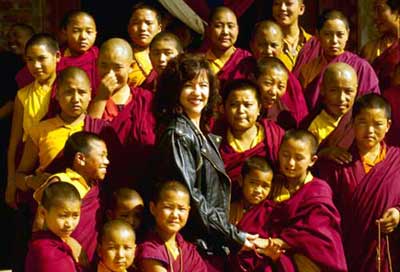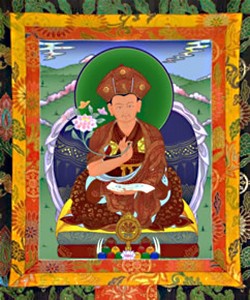His Holiness Khenpo Jigmey Phuntsok gave the following commentary on the recognition of Jetsunma Ahkon Lhamo on July 30, 1993 at Kunzang Palyul Choling in Poolesville, Maryland
Padma Norbu Rinpoche was discovered by the fifth Kongtrul Thupten Chokyi Dorje. Thubten Chokyi Dorje by indicating who Padma Norbu Rinpoche’s parents would be. When we look at the qualities of such a recognition, we find in someone like His Holiness Padma Norbu Rinpoche has lived up to every aspect of who he has been indicated to be, in terms of being an emanation of the previous Penor Rinpoche, in terms of the qualities of his scholarship, of his honor and morality, of his excellence and of his accomplishment which are all inconceivable. And so in terms of spiritual and secular qualities he is absolutely fully endowed and lives up perfectly to the recognition, which has been bestowed upon him.
It is someone as supreme as Mahasiddha Padma Norbu Rinpoche who with his eye of primordial wisdom awareness has understood that this is an incarnation of the previous Ahkön Lhamo. He has not recognized her just suddenly without basing it on any type of investigation, as though it were something that he just did spontaneously when it came to his mind. The recognition of her occurred as a process that he had been looking into for an extended period of time. He had been checking about who she was with his own heart deities, and he received some visions from his deities giving explanations to him. He also had other experiences in his meditation and experiences in his dreams and in the least, also received indications through divination procedures. And so when he finally made the formal recognition, it was from a point of view of total confidence.
As for Ahkön Lhamo herself, first we have to look at the status of her brother who is Vidyadhara Kunzang Sherab who came from the lower Do-Kham region of Tibet.
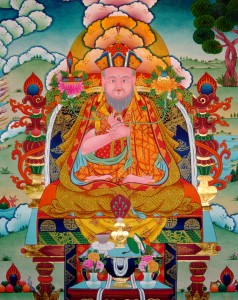
Secret Mantra Tradition
In terms of establishing the secret mantra tradition in this region of Tibet, there are three principal monasteries that were founded: Kadok, Palyul, and Dzogchen. And of these three, the Palyul mother monastery and its branches came to be, even in its time of origination, the most essential of the three monasteries for the establishment of the vehicle of secret mantra. Vidyadhara Kunzang Sherab was responsible for initially establishing the mother Palyul monastery from which there are now some three hundred branch institutions. His sister was Ahkön Lhamo and she was also very connected with him in these types of activities during their lifetime together. But she was primarily renowned for her ability to practice the Dharma. She was well-known as an accomplished yogini on outer, inner and secret levels who spent her entire life in practice And so this is why, later on, when she passed from that particular life she was well-known for the self-embossed syllable “ah” which appeared in her skull which was a sign of having achieved the highest accomplishment through the practice of that life.
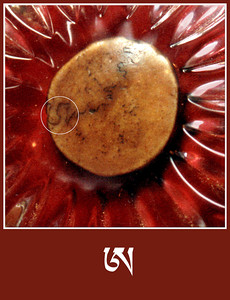
As a symbol of faith and devotion, it’s not an empty symbol. It is a symbol that exists due to scriptural authority and lineage, the lineage that she belongs to, the authority of the lineage as well as the scriptural references to that authority in the lineage. And so it is something that we can have confidence in terms of its validity. And so, therefore, we can also have confidence in her in terms of background, from a point of view of intelligence, and from the point of view of scientific proof.
We can have total confidence then, in terms of proof, that she is an exalted rebirth. Now in one way, in this lifetime, she appears as a common American woman, but in another way she appears very uncommon, because she has faith in the Dharma unlike that of a common person, and she has a very strong wish to be of benefit to others, which is unlike that of common people. She has a tremendous love for her lamas and her spiritual mentors and an ability to make impressions on the minds of others, and to actually control or have some positive influence on the minds of others. And so this sets her apart from the ranks of common folk.
Through her own wishes she traveled to India where the Dharma has existed for thousands of years. And there she had an opportunity to listen to the teachings and receive many teachings directly from His Holiness Penor Rinpoche so as to increase her own noble qualities.
She also had an opportunity to receive the entire transmission for the Rinchen Terdzod directly from His Holiness, all of the empowerments, all of the pith essential pointing out instructions and commentaries that are found in that precious terma treasury, and she received it in a way that an elderly lama would receive it, an elderly Tibetan lama. And so she had this opportunity to completely internalize all of those blessings, which is very extraordinary.
And from the time that the title of Ahkön Lhamo was bestowed upon her, she didn’t succumb to pride and arrogance and go on a separate pursuit, which would be of benefit to her with fame and glory. Instead she used that title to, even more than before, do what she could to accomplish the purpose of sentient beings and the doctrine, which she has been able to establish more extensively since her title has been bestowed upon her.
And I also think that her enlightened activities have been most excellent in terms of what she’s been able to manifest, the establishment of this temple which is filled with many wondrous supports of enlightened body, speech and mind, and all of the many stupas that she has been able to erect, which are found here on the grounds which are also amazing supports for the presence of the doctrine in this world.
Then also here in the dharma center, she has established the ordained sangha in a way, which is unlike any other place, with so many disciples who have taken the vows of ordination. This is a clear sign of her miraculous activities being manifest and her strong intention to accomplish the pure dharma in this land. Not only that, the lay householders in the community also obviously have very strong motivation towards the accumulation of that which is wholesome and that which is virtuous. And this unceasing effort towards prayer and practice carried on in the temple is yet a further display of her miraculous activities manifest.
What she has been able to accomplish up until now will continue to be accomplished in an even greater way in the future, and will have large effects on this country in general. Not just here in this place but in a widespread way. This will have an effect on many people in this country. And so this is yet a further sign of the wide-reaching effects of her miraculous activity, which will continue to increase.
And as the Buddha said that if there is fire, there will be smoke, as a sign of the fire. And if water; there will be a sign of water birds gathering there. Likewise, if there is a Bodhisattva, there will be a sign of the Bodhisattva’s presence, and that means there will be external signs that are apparent and those signs are signs of bringing benefit to sentient beings. This is something that we can notice and we then know that a Bodhisattva is amongst us.
As her students you should know how to rely upon her purely in the three ways. And you should do your best to accomplish the stages of learning and the stages of accomplishment so that the doctrine can be firmly established in this land, so that it can be of benefit to both self and all other beings.
Khenpo Jigme Phuntsok
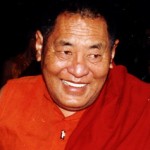
Khenpo Jigme Phuntsok (1933 – 2004) was a Nyingma lama from the Dhok region of Kham. At the age of two he was identified as the reincarnation of the Terton Sogyal, Lerab Lingpa (1852–1926). He studied Dzogchen at Nubzor Monastery, received novice ordination at 14, and full ordination at 22 (or 1955). Khenpo Jigme Phuntsok was the most influential lama of the Nyingma tradition of Tibetan Buddhism in contemporary Tibet. A Tibetan Buddhist meditation master and renowned teacher of Great Perfection (Dzogchen), he established the Serthar Buddhist Institute in 1980, known locally as Larung Gar, a non-sectarian study center with approximately 10,000 monks, nuns, and lay students at its highest count. He played an important role in revitalizing the teaching of Tibetan Buddhism following the liberalization of religious practice in 1980.
In July 1993, HH visited KPC, ordaining a number of monks & nuns, and giving empowerment and teachings on recent termas he had revealed.
